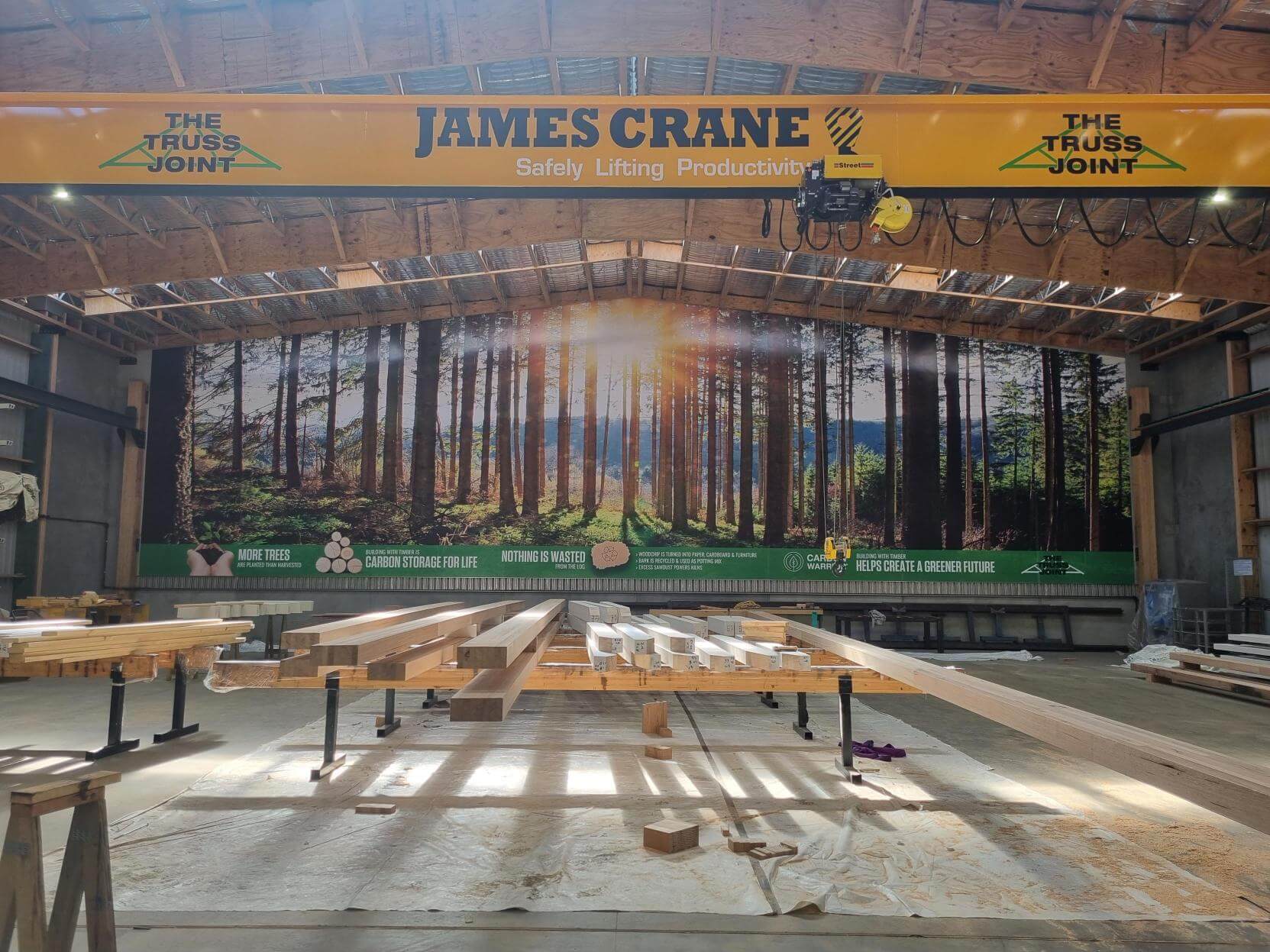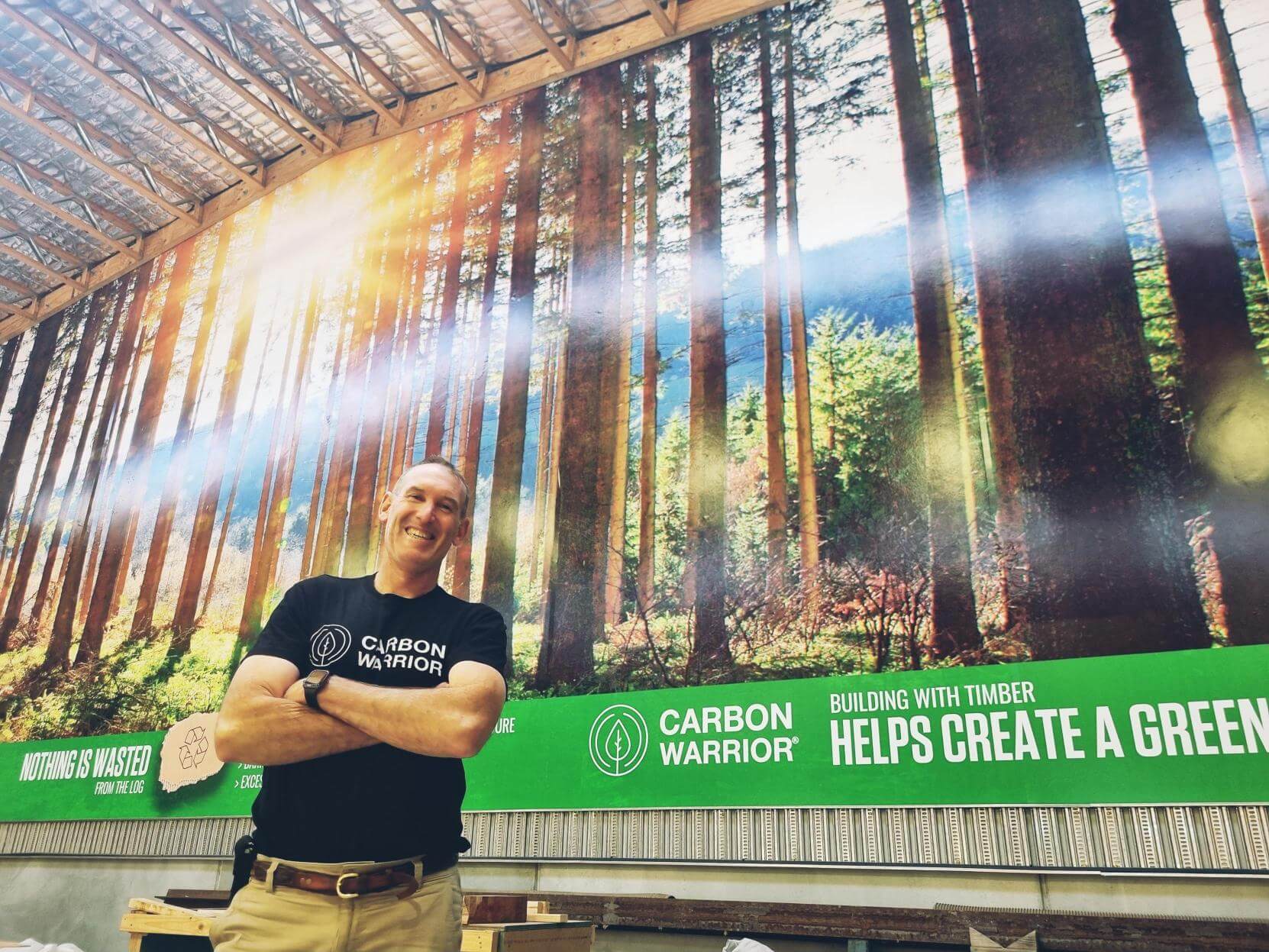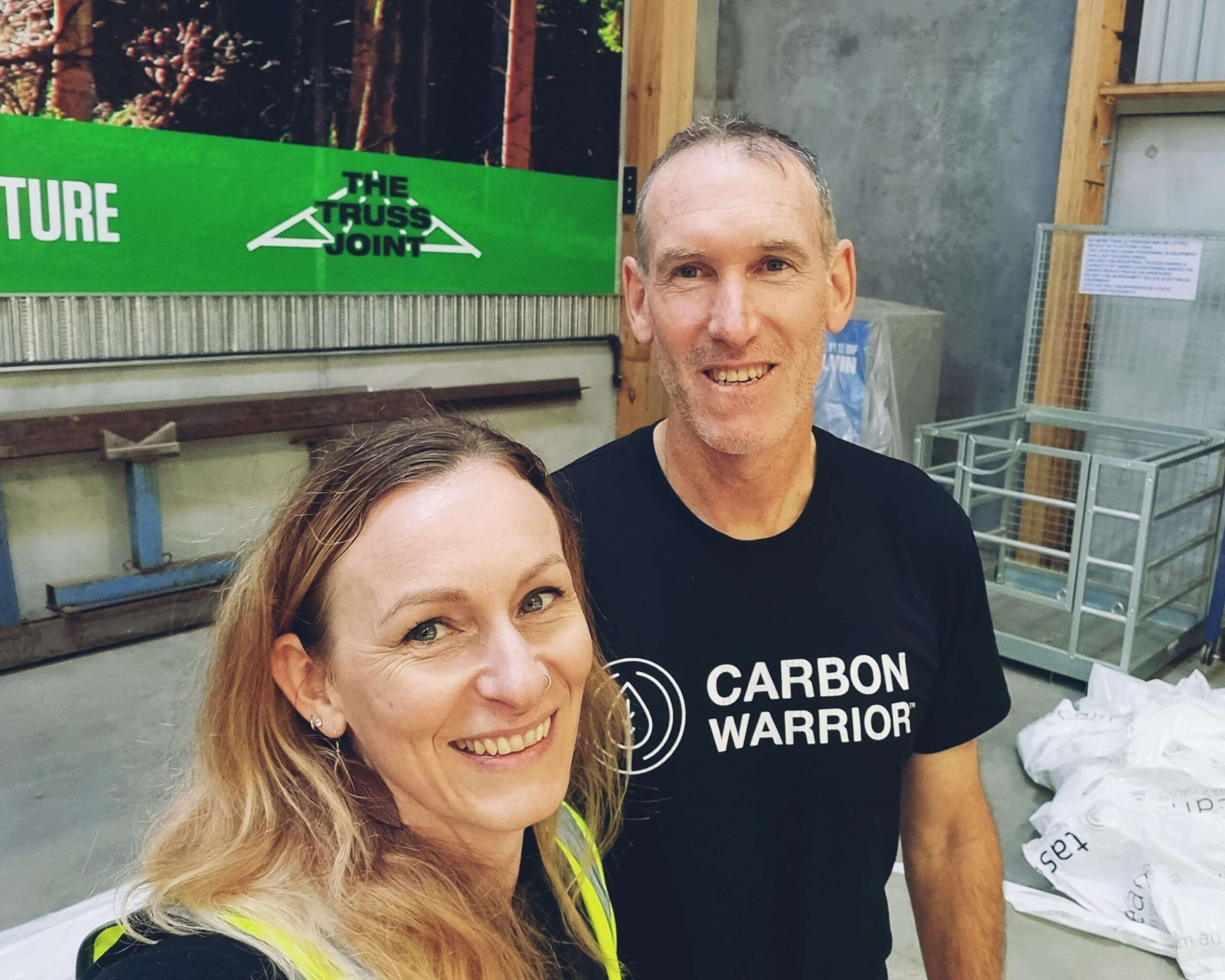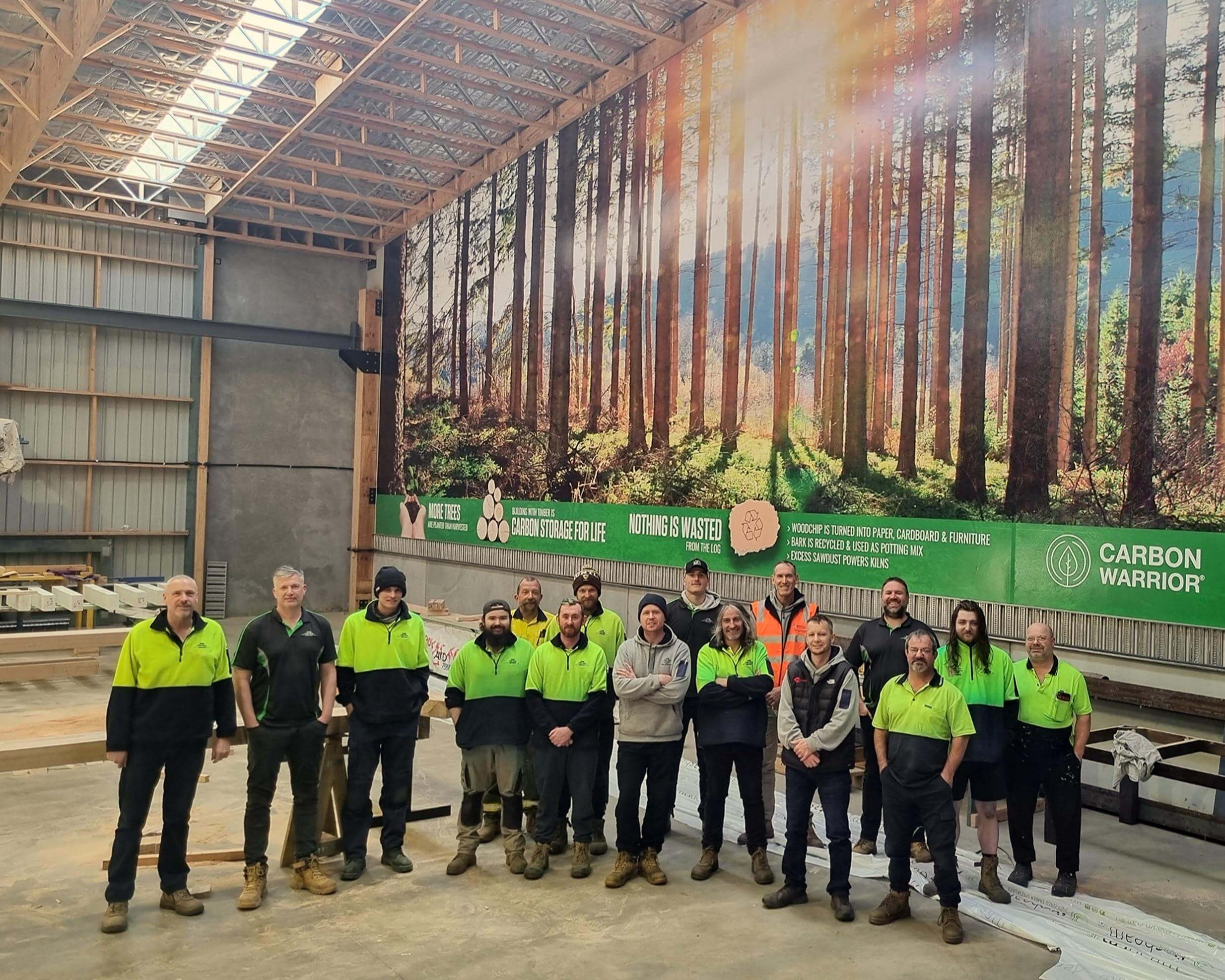This article was written by FTMA’s Kat Welsh.
It was a sunny day. One of those winter mornings where the crispness from the night, had just evaporated, and the deep blue cloudless sky stretched out above. Magpies, cockatoos, and butcherbirds, warbled in the eucalypts as I stepped out of my car at The Truss Joint. There was still a slight chill in the air as I followed the signs for the office. On arrival, I was redirected to the other enormous shed on the property, with instructions on how to find the boss man. I exited, and crossed the grounds to the second metal cladded building. Stepping into the shed, I was immediately surrounded – not by the expected internals of steel – but by the warm glow of wood.
Pillars, rafters, internal wall panelling.
Everywhere. I. Looked. There. Was. Wood.
Out of the corridor came Kirt, who greeted me warmly and took me upstairs to the office. The stairway was wood, and the walls also panelled. This was not what I was expecting from an industrial plant – being surrounded by complete uniqueness with the grains, the colours, and the tangy timber smell – it gave a vibe of warmth, homeliness and intrigue. I started to notice the details of the shed, the roof structures, the supporting joints, and the intricacies of the massive beams, all of which had once stood strong in a forest, and that now boldly supported the operation within.
Up in the office was Bruce, the owner of The Truss Joint, and the man behind the whole set-up. As I shook hands and shared greetings, my eyes locked on to the view of the plant floor below – through the windows, was the whole factory. Works were in progress, lengths of beautiful timbers, the buzz of saws, the forklift, and on the far wall was something else I hadn’t expected. There stood, a whole forest – dense trees, ferns, mountains and the sunlight filtering through an abundant scene of wildness.

Taking the concept of Roman fresco mural painting to whole new level, the entire rear wall of the shed was covered in the photographic scene. Along the bottom were key brand logos – promoting the fact that timber is renewable – to consciously remind everyone that the solution to climate change is what grows around us. I couldn’t look away from it. Besides the fact that having it there made it feel like you weren’t in an aircraft hangar but out hiking in nature, it also made it obvious that Bruce and everyone working at The Truss Joint are doing what they can to be part of the solution – working with wood, storing carbon, and promoting the incredible beauty of this natural resource.
The mural cost $12k – the message is priceless. It’s obvious that what drives the desires at The Truss Joint are the environmental impacts that using wood has, the splendour and uniqueness of the timber, and the legacy of craftmanship.
“There’s 70 tons of carbon stored in this shed,” Bruce said, “versus putting 500 tons back the other way with steel. It’s a carbon sink. This is what we’re passionate about.”
When it came to building the shed itself, the option to use steel versus timber was a consideration, but they knew that they had to be an example of what they do. It wasn’t just about making the business functional, but it was about embodying the principles of biophilic design as much as promoting them – to increase their own connection with nature and the natural environment.

Set up in 2008, The Truss Joint, is an evolving entity. Currently, there are two main sheds, both impressive in their operations. Whilst one focuses on building roof and floor trusses, the other – possibly the jewel in the crown – is making custom built exposed feature trusses.
The popularity for exposed timber framing is definitely on the increase in Australia. The Truss Joint is significant in what it’s doing to produce, not just something functional and environmental, but something remarkable. The list of woods used are endless, Tasmanian oak, recycled Oregon, spotted gum, Victorian ash to name a few. The plans to expand what they do, to build on the craft of exposed trusses, are well and truly in the pipeline.
Taking inspiration from the European timber framers, both Bruce and Kirt went to Germany in 2019 for a mass timber and prefabrication tour, and the LIGNA trade fair. The use of wood, traditional timber framing, and what we now call the biophilic principles, have for centuries been particularly strong in Germany. The wanderjahre training, or journeymen years, dates back to medieval practices for teaching, particularly, carpentry crafts. The practice still very much exists today and is a celebrated part of the culture – the use of timber in buildings is abundant and an art form. Bruce described, whilst driving around Germany, that it was obvious how much the country puts into replanting and growing trees. Between every township and village are plantations – working the cycle of nature and craft. “It might only be 2 acres, and you have to wait 80 years [to harvest], but they’re very patient people and have been doing it for thousands of years.”
Talking with Bruce and Kirt, it became obvious how much what they do means to them all. It’s not just a business. The knowledge of the environment, the woods, and the technologies was inspiring. And their willingness to share and spread the knowledge, incredible. Bruce described closing the gap between local builders and architects with promoting the uses of engineered wood products, and for example the use of Glulam, for structures. Their desire to get more on the education curriculum is significant; regarding carbon capturing, and rebranding the industry, which in Australia has for so long been connected to deforestation and contributing to environmental crisis. Their choice to showcase what can be done with their own workplace is a solid example of working with wood.
“I’ve been doing this for 35 years. I get this [the science of timber and carbon], and I get that not many people do. But how do we get through? We’ve just got to start.”
With the way climate change is impacting the earth, The Truss Joint are personifying the message that using wood, and re-forestation is the solution, not the culprit. “We’ve been underinvesting in our forests for such a long time. We can’t produce enough softwood in our own country to sustain our own building industry. And we have to… every bit of it is carbon storage,” Bruce said.
As Bruce took me on a tour of the whole site, what also came out as part of the formula, is how much everyone is valued. Everyone is part of the structure – they’re all part of glue, part of the wood, and part of the components that make up The Truss Joint. I was introduced to pretty much everybody as we went around, what role they did, how long they’ve been there, and how they’re connected in – brothers, sons, previous colleagues, mates, mate’s kids. The work site was a family, and a community. During COVID, it was a safe haven – to come together and to be a part of something. While they’re doing every bit they can for the environment, the key seems to be doing every bit to keep the comradery, and remembering that every function is essential.
As times are getting more challenging for the population – cost of living, communities under pressure, global pandemics – having a work anchorage with a sense of meaning and connection, is crucial.
Blown away, is probably how I would sum up my trip to The Truss Joint. The work, the morals, the knowledge, the utilising of skills, and the environmental underpinning was all abundant. It was humbling to see what the business is doing, achieving, and promoting. For me, as I am learning so many new things in this industry, it’s pretty special to be meeting people like this and being shown around with such insight and passion. The experience made the concepts tangible – to see, touch, and smell, what can be done to support the climate crisis. Knowing that every structure that these guys create, whether it’s a custom-built feature for all to see, or a wooden frame hidden by plaster, it’s all part of a legacy for carbon storage and something that will stand the test of time.
Massive thanks to Bruce, and to everyone, for your time, hard work, and dedication.


Our Principal Partners



